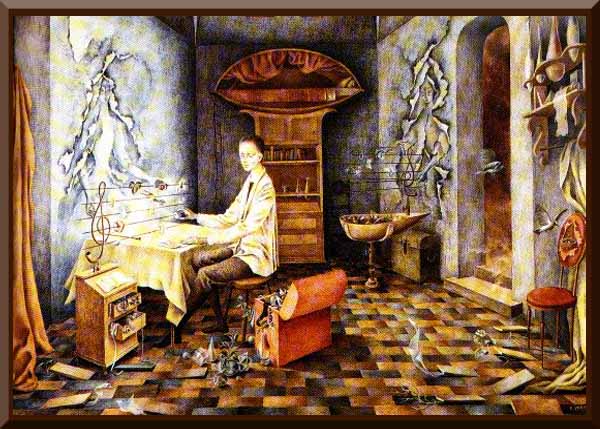Remedios Varo: Harmony
Excerpts from The New York Times-Science Forum
In “Harmony,” the distinctly androgynous scientist is seeking to create a “theory of everything,” using a musical staff, as an organizing device. The scientist strings onto the staff vegetables, animals, stones, pyramids, a scrap of paper with pi written out to six digits. Projecting from a wall near the staff, the hand of chance, an essential ingredient in scientific success, is helping the scientist by adding ingredients to the composition in progress.
Her extravagantly meticulous and multivalent paintings have long been celebrated in Mexico, her adopted home, and now, 37 years after her death, Ms. Varo is at last beginning to receive international acclaim, including the admiration of a cadre not always known for its arthouse savvy: the scientific community.<br/.
In a symposium at the National Museum for Women in the Arts, Dr. Friedman discussed the appeal Ms. Varo holds for scientists and engineers. He described how the artist metaphorically conveyed in her paintings some of the most revolutionary and complex scientific theories of the age, from Einstein’s special theory of relativity and Darwin’s theory of evolution by natural selection to the premise that humans are the stuff of stars, their bodies built of elements baked in solar bellies millions or billions of years ago.<br/.
“How many paintings have the square root of minus one in them?” he asked rhetorically in an interview. “Clearly she’s fascinated by science. Her paintings include lots of machinery, gears and pulleys and cranks, test tubes and orreries,” mechanical models of the solar system.
.
One of the first textbooks about general relativity,”The Riddle of Gravitation,” by Peter Bergmann, displayed one of Varo’s paintings, “The Phenomenon of Weightlessness,” on its cover.
Varo sought in particular to convey the most profound and creative moments in a scientist’s life, when the researcher first dares to imagine an alternate universe, a model of how things work that differs radically from the models preceding it. “What she’s doing, uniquely among artists, is presenting this core moment of discovery that’s so exciting in science,she realized that this central act of the imagination in science, this free play of the mind, is very similar to what artists do.”

